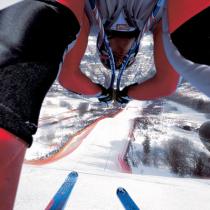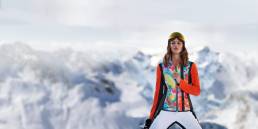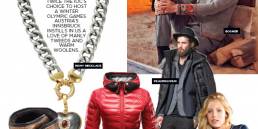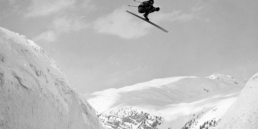Austria’s Hahnenkamm is the most famous downhill course in ski racing — treacherous, unforgiving, and good practice for the party that follows.
by Roger Toll
Three seconds after launching onto the Streif a skier will reach 60 miles an hour, an acceleration equal to that of the fastest Ferrari. Plummeting in two minutes over two miles and nearly 3,000 vertical feet, the course assaults the racer with the laws of physics faster than a human can consciously react — faster, arguably, than he can think. To reach the finish line he will need to call on instantaneous judgments, ingrained instinct, raw talent, years of experience, luck, and ski technique as inconceivable to a weekend skier as quantum physics is to a ninth-grade algebra student.
At that finish line, 50,000 fans roar. Physics be damned.
It is a mid-January weekend in Kitzbühel, Austria, and the most stark raving mad street party on Earth — the Super Bowl and Mardi Gras rolled into one — has been raging since the Hahnenkamm downhill ended six hours earlier. Most who have descended on this mountain town to witness the alpine World Cup’s most demanding, demented race have been liberally patronizing the canvas kiosks lining the picture-perfect streets, downing liters of beer and endless glasses of wine in the process. A deejay cranks Euro-techno, pop, and rock at unhealthy decibels, and people are dancing in the streets or winding through the nearly impenetrable crowds in long serpentine lines.
The frenzied mob is drunk — from the contact high of the crowd as well as the unending flow of booze. Wearing strings of flashing lights or Tyrolean hats, their faces painted in national colors, they wave flags with one hand and hoist glasses with the other, dancing and jumping in deft inebriation.
At midnight, the party is still going strong. The evidence of excess is everywhere. Many in the young crowd are still standing, dancing solo jigs by themselves, while others are on all fours howling at the ground. At the famous pub The Londoner, shirtless Canadian and U.S. racers bow to tradition behind the bar, serving beers that pass hand by hand through the densely packed crowd. There’s no way to move from the spot you occupy.
It has been like this all weekend, starting with a gala peopled by the kind of jet-set party crowd that flows from one international sporting event to the next: Monaco’s Prince Albert, Crown Prince Mohammed of Bahrain, Formula One superstar Michael Schumacher. Skiing greats — Franz Klammer, Franz Webber, Patrick Ortlieb, Alberto Tomba, Marc Girardelli — and the local elite mix with statesmen, business leaders, and society swells from Vienna, Munich, Zurich, and elsewhere in Europe to the strains of Gloria Gaynor singing “I Will Survive.” Young glamazons, clad in dresses better suited to summer in Monaco, dance through the night fueled by Red Bull and vodka, in the Kitzbühel tradition of moving straight from the party to breakfast and on to the downhill, where the festivities continue in the VIP viewing area at the bottom of the Streif.
The Hahnenkamm is the world’s most famous downhill course, the most treacherous and unforgiving event on the men’s alpine World Cup tour. Its two miles of sharp fall-line turns, jet-fighter G-forces, massive jumps, and radical steeps — water-doused into a rock-hard surface of ice — make the toughest racers quake. Even the 2008 winner, Swiss star Didier Cuche, admitted, “When you are at the start, you wonder how it is possible to get down.” Each racer knows that it may be he who ends up in the orange gill nets at the humbling end of a spectacular wipeout. Or worse.
Four athletes were carried off the course last year. An Austrian racer broke two vertebrae. A Czech and an Austrian fractured right legs. American Scott Macartney, at 90 miles per hour, came off the final jump askew and was unable to right himself. He landed on his hip, slammed his head into the ice-hardened course, then slid 200 feet across the finish line, limp and unconscious, twitching spasmodically. Fifty thousand people — and millions more glued to TV screens — fell silent. Twenty minutes later, wrapped like a mummy and hoisted into a hovering helicopter, he was transferred to the hospital. Miraculously, he suffered nothing more than a severe concussion.
For three days prior to Saturday’s race — even as the Austrian press told him, in sneering headlines, to shut up — American bad boy Bode Miller had ripped the organizing committee for allowing changes to the lip on the last jump, and Macartney’s crash sent him over the edge: “You don’t expect the organizers to try to make the course more bumpy or tough than the hill is. We’re going to be pushing the limits because that’s how you go the fastest. To make it worse just to make it spectacular … It’s just not the way to manage a downhill where guys can easily get hurt or get killed.”
“It is more aggressive than it used to be,” says Gerhard Ortner. But he is talking about the party, not the race. We are sitting in a coffeehouse Monday morning, when the whole town seems to be convalescing from a hangover. He has lived all of his 60 years here and knows everyone in town. “The young people are bringing a rock concert culture. Kitzbühelers stay home on race day now. I walked around just after dark when the streets were most crowded, and did not see one person I know.” Nor, seemingly, anyone who longs for the Kitzbühel of old — even Austria’s homegrown ski-racing heroes are taking a back seat to new, rowdier blood.
“I looove Bode!” She stands on the snow at the evening’s awards ceremony, waving an American flag; I ask her where in the States she hails from. “Steiermack, near here,” she says in a halting English. She plants the flagstaff in the snow and opens another beer. “Bodeee is the best.”
“I’m for Bode,” says a man wearing a hat of Swedish colors, “but I’m Austrian.” And the cap? “I want to be Swedish, but they don’t have good downhillers. And I love the way Bode skis.”
Two ragtag Austrians, university students on a bender, hike across the snow to reach the finish area with a huge American flag between them. “Bode for president!” they yell.
In this ski-crazed nation, young Austrians are attached to just about every Stars and Stripes I see. Why this show of trans-Atlantic allegiance? Perhaps it is Bode’s authentic American-ness: He’s the anti-institutional individualist, battling the arrogance of authority as Don Quixote battled windmills. His say-it-like-it-is candor speaks strongly to Europe’s young. He is what they would like to be.
Twenty minutes after Macartney’s crash, Bode Miller loaded the gate. Starting 16th, he was running fast at the edge of disaster when, coming into a hard right turn, he hit a bump that threw him off his line toward a potentially race-ending encounter with the protective fence. He raised his left ski, then his right, onto the fencing and skied for 50 feet, as if on some bizarre ski-cross course, then dropped back onto the snow. The crowd, experienced viewers of Europe’s ubiquitous televised ski races, roared in disbelief as the announcer went wild. Despite the speed lost to friction as he burned a streak across the plastic fence, Miller took second place. Later, still seething over Macartney’s fate, Miller continued his critique of the course. “To have one of my close friends go off it and knock himself out and be convulsing on the snow, that’s not what you want to see before you have to run the course. It’s people’s lives at stake there.”
At the other end of the spectrum, with his nice-guy grin, is slalom racer turned speed demon Steve Nyman. “This downhill is never a gimme,” he says. “You have to have the skill to ski it fast, but also the guts.” He skied well, but a fog belt threw him off his line and his time was sluggish. “My heart wasn’t in it after Mac fell,” he said afterward. “There’s a gear you seek, the ability to push harder. Look at Bode. He didn’t ski clean but he finished second. I was scared coming down. To do well in Kitzbühel, you have to put yourself on that uncomfortable line between staying on your skis and being completely out of control.”
“It’s demented!” he went on. “One demanding section after another. It’s the gnarliest hill there is.”
After all that, I had to experience Hahnenkamm for myself. I had parked my skis and boots in a locker at the base of the gondola not far from the media center, hoping to get into the vast ski territory of the stunning Kitzbühel Alps over the long weekend. But between the parties, the media conferences, and the races — super G on Friday, downhill on Saturday, and slalom on Sunday — there was little downtime. I got into the high country twice, and raced around the above-timberline sea of white on runs hardly distinguishable from the off-piste terrain through which they coursed. Conditions were closer to classic New England — clatter, clatter — than Utah powder, but the limitless beauty of the high country made up for it.
Skiing past a mountain hut near the top, I heard the oompa-oompa of a tuba and put on the brakes. Inside, a party celebrated Fritz Strobl’s retirement from the World Cup. The Austrian ski industry’s guests’ ruddy faces had turned a brighter shade of crimson, either from the warm, sunny days or from the shots of schnapps circulating liberally on trays. I joined them in tucking into platefuls of bratwurst, dried meat, and local cheeses, and in chasing the schnapps with glasses of beer. And schnapps, and beer, and schnapps.
It was a crazy weekend, no matter where you found yourself.
SNOW Tidbits:
*Former U.S. Ski Team spokesman Marc Habermann had his own take on Miller’s comments: “Bode was right to say that the takeoff on the last jump where Scott fell was different every day. Scott did not stay crouched on takeoff, it’s true, but the lip played into the problem. Bode is a guy who speaks his mind, and he’s not afraid to complain about jury decisions, start intervals, safety issues. And if the race crew keeps changing the finish jump, you’re going to hear from him.”
*The best place to recuperate from the all-night parties is Aquarena, a large co-ed public spa with a variety of saunas, steam rooms, hot and cold baths, massages, a relaxation room, a 25-meter pool, and a Turkish bath — all straightforward, simple and delightful, and much used by locals.
*In the ski world, Austrians have a reputation as mechanized animals: superb, oversized, highly disciplined racers with years in ski academies under their belts, while Americans are thought of as cowboys with natural skill but a lack of consistency and discipline. I asked Austrian downhill racing star Michael Walchhofer, who has trained with Miller and other American skiers, if there is some truth to this stereotyping.
“Austria is a small country, and skiing is our top sport,” he said. “But I bet there are as many skiers in America’s mountainous states as we have here. Sure, there is less support for skiing there, and maybe the best athletes go into a more popular sport. But because skiing is so important here, we do everything we can to be as successful as possible during the short time we have as competitive athletes. It is an investment in the rest of our lives. We are disciplined, but we also like to have fun. Maybe the American skiers like to have more fun and, yes, maybe your racers take life a little easier than we do.”
*Miller’s Kitzbühel victory in the combined event last year vaulted him past Phil Mahre’s 26-year-old U.S. record of 27 World Cup wins and launched him on his way to winning last year’s overall World Cup championship for the second time. With three downhill victories last year, as well as the second-place finish in Kitzbühel, he missed — by a mere five points — the downhill title as well. With a total of 31 World Cup wins so far, he is now the sixth best ski racer in history, after skiing legends Ingemar Stenmark, Hermann Maier, Alberto Tomba, Marc Girardelli, and Pirmin Zurbriggen.
His spectacular achievement helped carry the U.S. alpine racers to their most successful World Cup season ever, winning five of 12 possible alpine World Cup titles. Besides Miller’s super combined and overall titles, Ted Ligety took the giant slalom title and, on the women’s side, Lindsey Vonn won the downhill and overall titles.





